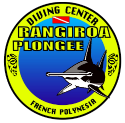Dive Sites Of Rangiroa, French Polynesia
Avatoru Pass (Incoming Current)
The small pass: This dive location is certainly for the more advanced divers in the crowd. The Avatoru pass has two channels that are separated by a tiny islet at the entrance to the lagoon. On one side it is quite wide and not all that great from a scuba divers perspective. The other side is much smaller and therefor called the small pass. This small pass features some very strong unpredictable currents. Depth isn’t the issue at this site. This dive site is far and away the most colorful of the dive sites you will get to witness while diving in Rangiroa. Some of the more exciting marine life you may witness here include manta rays, and white tip sharks. After going through the small pass you will find yourself in the lagoon which has much more calm waters and this is where your dive will end.
Avatoru Pass (Outgoing Current)
Tiputa Pass (Incoming Current)
The Canyons : In this dive we generally stop in the cavern to begin in hopes of spotting the multitude of grey reef sharks. The difference lies that once in the Tiputa Pass, roughly half-way, we will veer to the middle of the pass and stop at several canyons which exist naturally. These canyons go across the Tiputa pass width wise. This is best done by experienced divers as we spend a lot of time in the middle of the pass where there is a strong current. This is a fantastic place in the June and July to witness a lot of Gray reef sharks. There is also the chance to see the great hammerheads at this location.
The run : This is a very deep dive which is done only by the most experienced of divers. It is done at the mouth of the pass and is generally done in January, February and March during our great hammerhead season. The dive can reach depths between 150 and 180 feet. There are also schools of rays which frequent this site. This dive like the others ends after you drift into the interior of the lagoon and decompress.
The Crossing : This is a dive perfect for the most experienced divers. As this dive sites name suggests, you will begin the dive on the opposite side of the Pass as the Cavern and cross the pass at around 165 feet. Upon making the crossing you will find yourself at the cavern where you will then follow the current into the lagoon again. The trick to this dive is staying quite deep as the current at the bottom is not as strong as near the surface, so the crossing is much easier at the 165 foot mark.
Tiputa Pass (Outgoing Current)
All dives are located on the right ocean-side slope of the pass:
The windmill: This is a fantastic opportunity for divers to witness a lot of the non shark species which we have in Rangiroa. This dive can feature dolphins, mantas, sting rays, tuna, wrasses, and sea turtles. The dive is done out of the way of the current and is done with a max depth of 82 to 85 feet. This is one of our dives which is available to all levels of certified divers.
The Blue: The dive starts at the same point as the Windmill but instead of swimming along the bottom of 82 to 85 feet, you will be swimming outwards where you will have approximately 820 feet below your fins. Although the visibility in Rangiroa is fantastic, everything fades from blue to black as you look down. The main purpose of this dive is to see the Albimarginatus (silver tip shark) but can also lead to some nice silky sharks if lucky. This is the one location where baiting is done by dive shops. At around 50 feet the boat man may bait the sharks here. This is a perfect opportunity for photographers to get some great photos of our shark friends. After our stay here we will swim back towards the reef and end the dive in the same ways as the windmill. Decompressing along the reef in a safe manner.
The Angle: This is another one of our dives which is open to all certified divers. The dive can also be done by more experienced divers at a depth of around 150 feet and is a great opportunity to see manta rays, some grey reef sharks, sting rays, or possibly even the great hammerhead. While most of the bigger animals are found at depth, at around 80 feet where level 1 certified divers can dive, there is a great chance to get lost in a school of barracuda.

